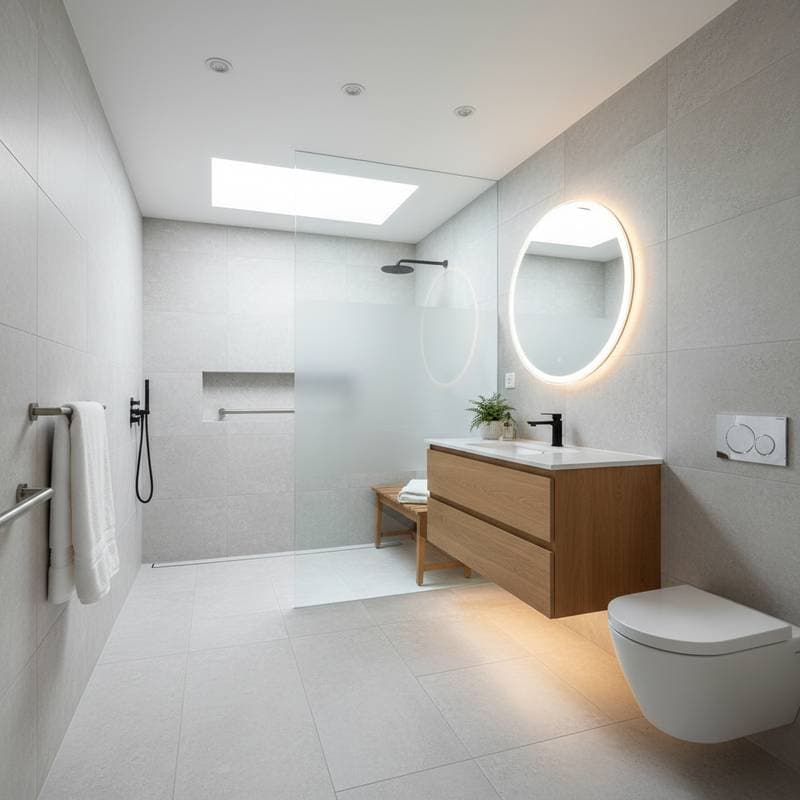The Rise of Japandi Wet Rooms in 2025 Bathroom Design
Homeowners increasingly abandon ornate, tile-dominated bathrooms in favor of expansive, streamlined wet rooms infused with Japandi aesthetics. This harmonious integration of Japanese minimalism and Scandinavian hygge emerges as the premier choice for contemporary remodels. The style captivates with its soothing ambiance, straightforward upkeep, and enduring visual harmony. However, this growing enthusiasm introduces critical building challenges that often escape notice until complications emerge.
Essential Precautions for Wet Room Construction
A wet room extends beyond a mere doorless shower; it constitutes a comprehensively sealed zone demanding meticulous design and professional execution. Even minor deviations in floor gradient can trap moisture in recesses, fostering mold growth and compromising structural integrity. Numerous projects falter when owners opt for informal labor over certified specialists to cut expenses, only to face discolored grout and subsurface leaks within a short period.
Effective waterproofing layers, strategic drain positioning, and robust ventilation systems must integrate seamlessly. Overlooking any component invites substantial remediation costs. Essential elements include accurate sloping, impermeable seams, and moisture-resistant barriers. True Japandi wet rooms thrive on this dual commitment to visual refinement and engineering accuracy.
To mitigate risks, conduct a preliminary site assessment that evaluates subfloor stability and existing plumbing. Engage architects or certified installers early to model water flow patterns using digital simulations. These steps prevent surprises and ensure compliance with local building codes, safeguarding long-term performance.
How Japandi Enhances the Wet Room Experience
Japandi aligns perfectly with wet room principles by merging Japanese geometric purity with Scandinavian tactile richness. The outcome yields a sanctuary that radiates tranquility without austerity. Selections such as pale oak cabinetry, bamboo accents, and matte stone flooring infuse subtle warmth, complemented by subdued palettes and diffused illumination for a composed environment.
- Streamlined surfaces promote accessibility and simplify daily cleaning routines.
- Organic elements withstand humidity while developing a patina that enhances character over time.
- Subtle hues expand perceived space and amplify natural light in compact areas.
- Embedded fixtures highlight material nuances and contours, avoiding stark contrasts.
Each decision in a Japandi wet room balances aesthetics and utility. Professionals emphasize that restraint demands foresight; with fewer components, individual quality assumes greater importance. Consider incorporating underfloor heating to amplify comfort, seamlessly integrated to preserve the floor's unbroken plane.
Key Installation Considerations for Homeowners
Wet rooms necessitate extensive groundwork surpassing conventional bathroom setups. Prior to surface applications, reinforce the substrate and validate the sealing protocol through pressure testing. Wooden bases require supplemental supports and precise leveling to accommodate the incline directing water to the outlet. Slab foundations streamline efforts but still demand high-grade protective coatings.
Budget planners frequently undervalue sophisticated drainage solutions. Linear channels suit Japandi profiles by preserving flush transitions, yet demand laser-guided placement. Slight offsets result in chronic water accumulation. Verify that collaborating plumbers hold credentials in specialized systems, including those with anti-siphon valves to avert backups.
Air circulation merits equal attention. Excessive vapor erodes superior builds if extraction units prove inadequate or mispositioned. Select low-decibel models with humidity sensors that activate automatically, preserving acoustic serenity while upholding optimal conditions. Integrate these with whole-home dehumidifiers for enhanced resilience in humid climates.
Strategies for Long-Term Wet Room Preservation
Constructed to exacting standards, a Japandi wet room endures for generations with routine attention. Employ pH-neutral solutions and soft cloths to protect finishes and barriers from wear. Refresh sealant applications on grout and joints per manufacturer guidelines, typically every 12 to 18 months. Regularly inspect and clear outlets to inhibit sediment accumulation.
Incorporate smart monitoring tools, such as moisture detectors, to alert for early issues. Annual professional inspections catch subtle shifts in slope or seal integrity, averting major interventions. These practices sustain the space's pristine state.
Realizing Enduring Value Through Japandi Design
The Japandi wet room embodies equilibrium, intertwining artistry with utility and poise with purpose. Properly realized, it transforms routine hygiene into a rejuvenating practice. For those prioritizing superior build quality, this approach transcends fleeting fashion, delivering amplified livability, property enhancement, and serene satisfaction.










